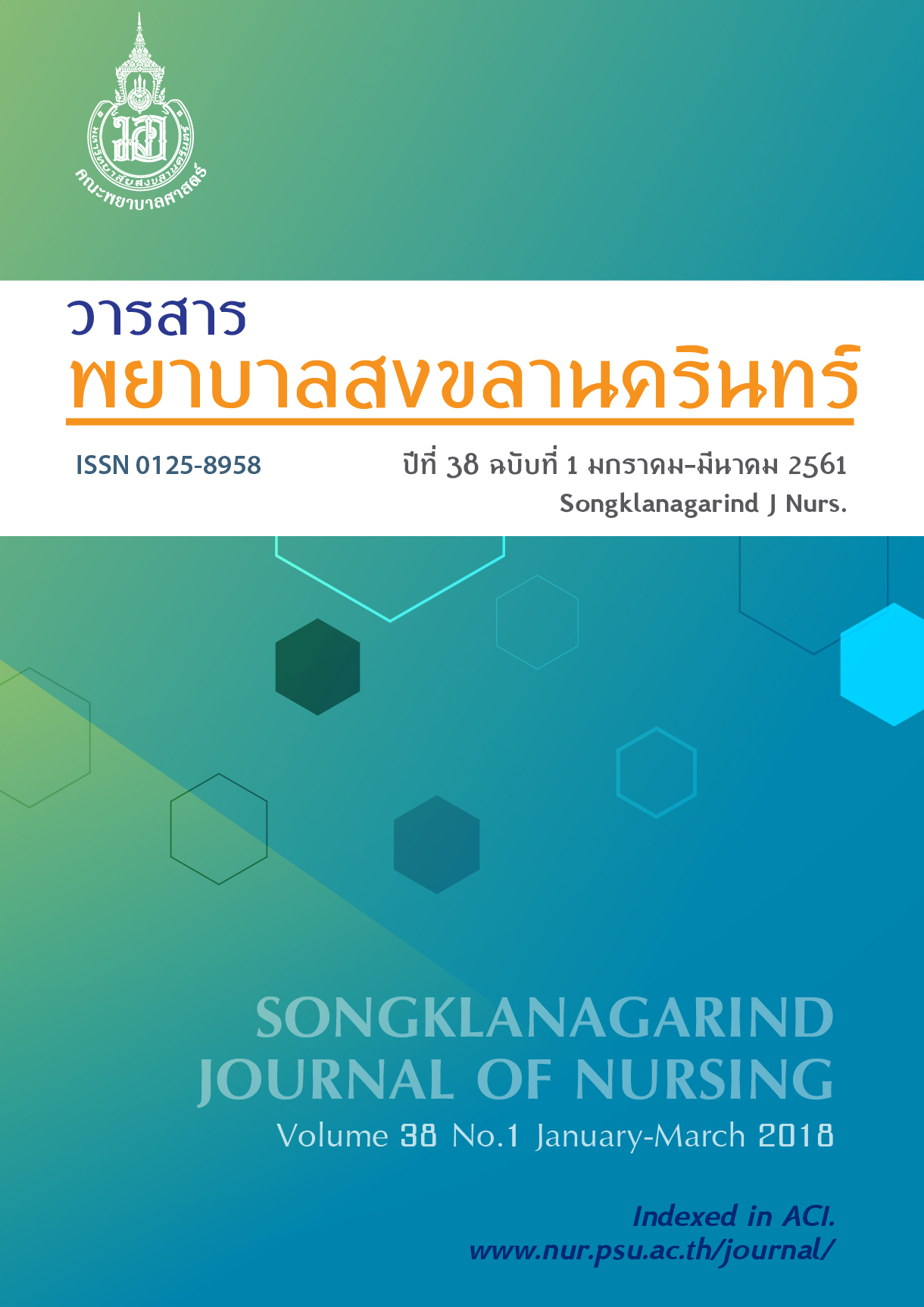Growth and Development in Children with Congenital Heart Disease
Main Article Content
Abstract
This comparative descriptive study aimed to evaluate and compare the growth and development of children with congenital heart disease, between acyanotic and cyanotic groups, and of children with congenital heart disease in healthy children aged 1-3 years. The sample consisted of 68 children with congenital heart disease who followed-up at a clinic or were admitted in a pediatric ward in one tertiary hospital, Songkhla, and 76 healthy children in a university child-development center, Hat Yai District. Research instruments included a questionnaire, growth chart, and Denver II test form. Descriptive statistics and chi-square test were used for data analysis.
The findings indicated that children with acyanotic and cyanotic congenital heart disease had significantly different growth in every criterion (weight for age, height for age, and weight for height) (p< .05). Comparing children in acyanotic and cyanotic groups, underweight was identified in 34.8% and 72.7%, stunting was 41.3% and 68.2%, and wasting was 28.3% and 54.5%, respectively. However, development was not different in both groups (p> .05). Suspected delayed development was identified in 41.3% and 63.6% among the acyanotic and cyanotic groups, respectively. When compared to the healthygroup, children with congenital heart disease had significantly different growth and development (p< .001).
Based on the findings, nurses’ roles in child growth and developmental surveillance should be encouraged, and developmental screening should be regularly performed among children with congenital heart disease.
Article Details
References
2. Frankenburg WK, Dodds J, Archer P, et al. The Denver II: A major revision and restandardization of the denver developmental screening test. Pediatrics. 1992; 89(1): 91-7.
3. National statistical office. Number of patients classified by 75 causes of illness from public health facilities of the ministry of public health whole kingdom 2003–2012 [Internet]. [cited 2015 Jun 13]. Available from: http://service.nso.go.th/nso/web/statseries/statseries09.html
4. Hsu DT, Pearson GD. Heart failure in children part I: History, etiology, and pathophysiology. Cir Heart Fail. 2009; 2(1): 63-70. doi: 10.1161/CIRCHEARTFAILURE.108.820217
5. Wongswadiwat Y. Pediatrics of congenital heart disease. Bangkok: Igroup Press; 2011. Thai.
6. Aditsuda P, Plubrukarn R. Development and child behavior. Bangkok: Holistic Publishing; 2007. Thai
7. Nousi D, Christou A. Factors affecting the quality of life in children with congenital heart disease. Health Sci J. 2010; 4(2): 94-100.
8. Hassan BA, Albanna EA, Morsy SM, et al. Nutritional status in children with un-operated congenital heart disease: An egyptian center experience. Front Pediatr. 2015;3:1-5. doi: 10.3389/fped.2015.00053
9. Okoromah CA, Ekure EN, Lesi FE, et al. Prevalence, profile and predictors of malnutrition in children with congenital heart defects: A case–control observational study. Arch Dis Child. 2011; 96(4):354-60. doi: 10.1136/adc.2009.176644
10. Chen CW, Li CY, Wang JK. Growth and development of children with congenital heart disease. J Adv Nurs. 2004;47(3):260-9. doi: 10.1111/j.1365-2648.2004.03090.x
11. Polat S, Okuyaz C, Hallıoğlu O, et al. Evaluation of growth and neurodevelopment in children with congenital heart disease. Pediatr Int. 2011;53(3):345-9. doi: 10.1111/j.1442-200X.2010.03230.x
12. Nasiruzzaman AHM, Hussain MZ, Baki MA, et al. Growth and developmental status of children with congenital heart disease. Bangladesh Med J. 2014;40(2):54-7.
13. Bjarnason Wehrens B, Dordel S, Schickendantz S, et al. Motor development in children withcongenital cardiac diseases compared to their healthy peers. Cardiol Young. 2007;17(5):487-98. doi: 10.1017/s1047951107001023
14. Chatrum K. The relationships between caregiver’s behaviors and growth, and motor development of children with congenital heart disease [thesis].[Khon Kaen]:Khon Kaen University; 2003. 85 p.
15. Ratanachu-Ek S, Pongdara A. Nutritional status of pediatric patients with congenital heart disease: Pre and post cardiac surgery. J Med Assoc Thai.2011;94(3):133-7.
16. Isaranurug S, Suthisukon P. Parenting. Journal of Public Health and Development. 2007;5(1):105-18.Thai.
17. Shah GS, Singh MK, Pandey TR, et al. Incidence of congenital heart disease in tertiary care hospital. Kathmandu Univ Med J. 2008;6(1):33-6.
18. Kliegman RM, Behrman RE, Jenson HB, et al. Nelson textbook of pediatrics. 18th ed. Philadelphia: Saunders Elsevier;2007.
19. Sirijongkoltong B. Pediatrics for medical practice. Bangkok: Igroup Press; 2010.Thai.
20. Thonginnet S. Pediatrics 2. Bangkok: Noppachai Printing; 2011.Thai
21. Rerksuppaphol S. Nutrition assessment. Bangkok: Pimsuay; 2007.Thai.
22. Chaikitpinyo A, Panamonta M, Tantisirin C, et al. The clinical outcomes in children with cyanotic congenital heart diseases at Srinagarind hospital (1992-2002). Srinagarind Med J. 2007;22(1):24-31.Thai.
23. Di Maria MV, Glatz AC, Ravishankar C, et al. Supplemental tube feeding does not mitigate weight loss in infants with shunt-dependent single-ventricle physiology. Pediatr Cardiol. 2013;34(6):1350-6. doi: 10.1007/s00246-013-0648-x
24. Arodiwe I, Chinawa J, Ujunwa F, et al. Nutritional status of congenital heart disease (CHD) patients: Burden and determinant of malnutrition at university of Nigeria teaching hospital Ituku-Ozalla, Enugu. Pak J Med Sci. 2015;31(5):1140-5. doi: 10.12669/pjms.315.6837
25. Srichantaranit A, Chontawan R. Caring for infantswith congenital heart disease prior to cardiac surgery: The impacts on families. J Nurs Sci. 2011;29(suppl 2):7-18.Thai.
26. Vaidyanathan B, Nair SB, Sundaram KR, et al. Malnutrition in children with congenital heart disease (CHD) determinants and short term impact of corrective intervention. Indian Pediatr. 2008;45(7):541-6.
27. Mussatto KA, Hoffmann RG, Hoffman GM, et al. Risk and prevalence of developmental delay in young children with congenital heart disease. Pediatr. 2014;133(3):e570-7.
28. Khamenkan K. Children’s thoughts and feelings during hospitalization :Nursing management. J Nurs Sci. 2011;34(3):75-87.Thai.


